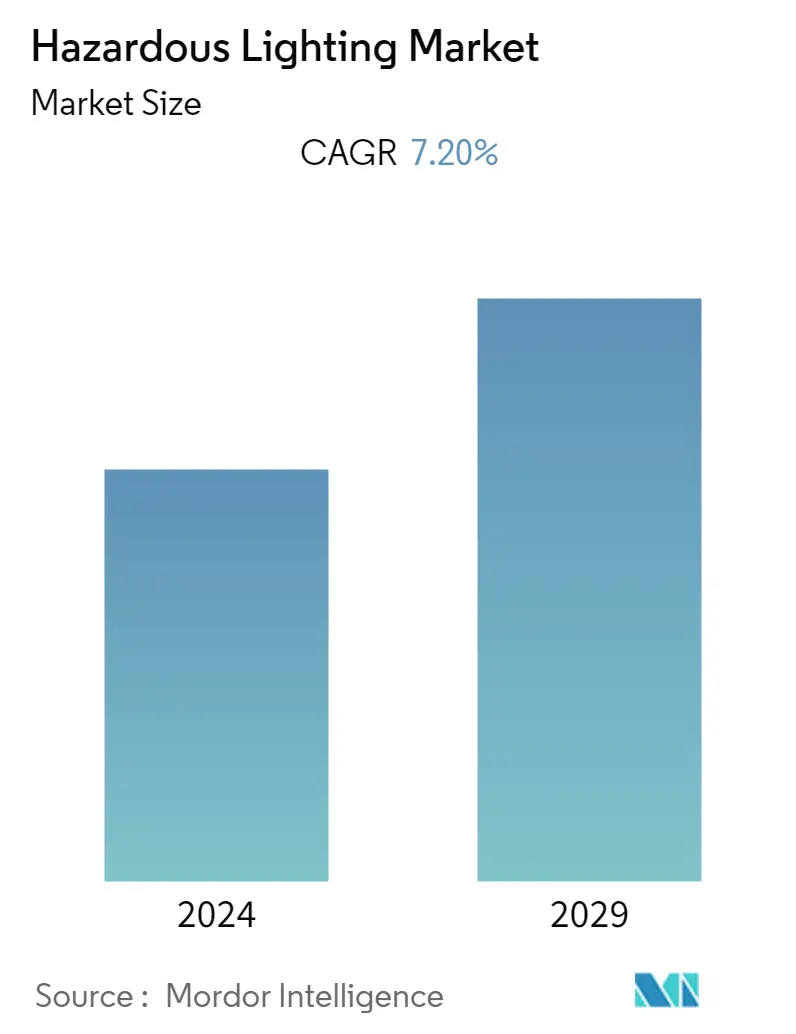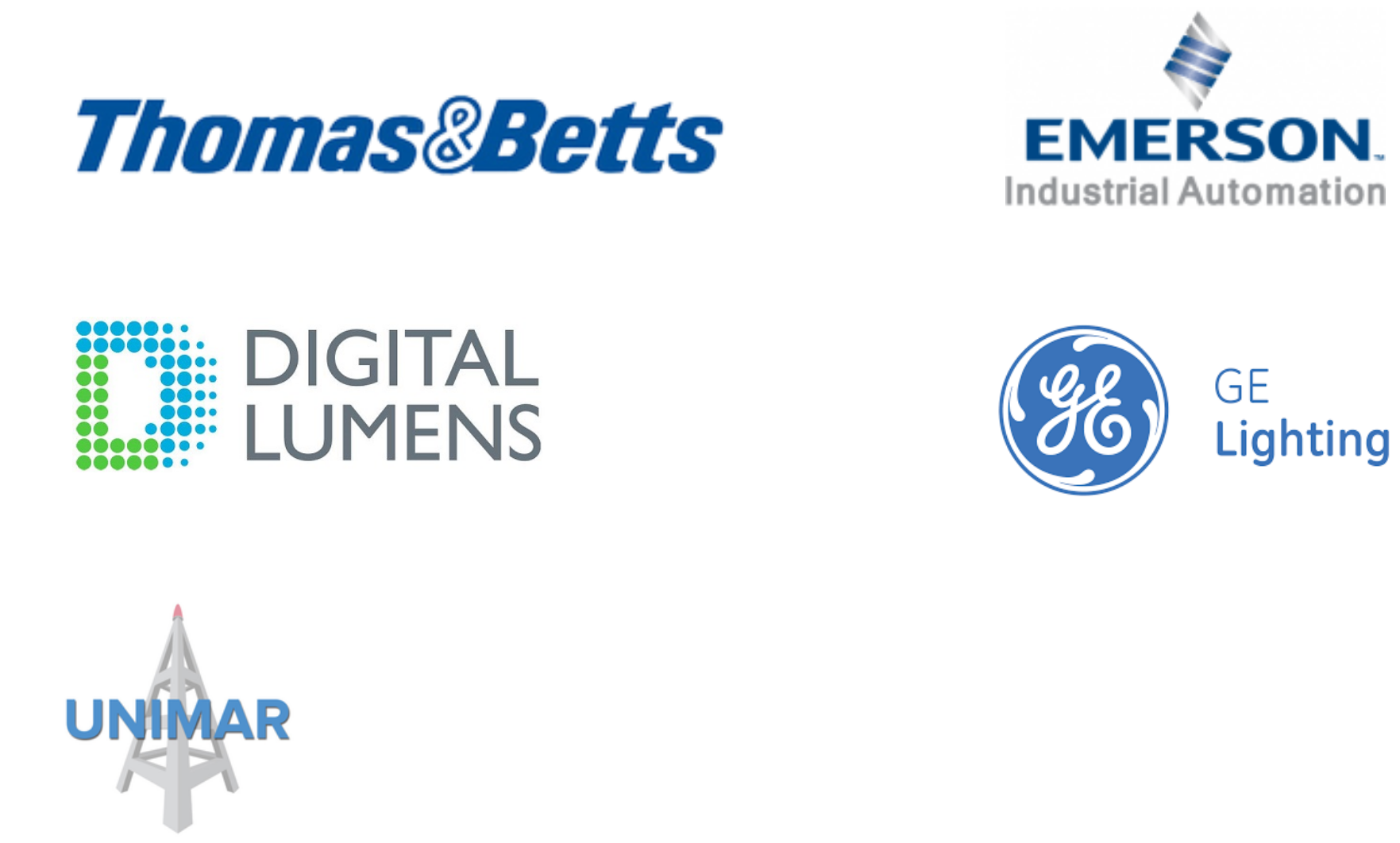Market Size of Hazardous Lighting Industry

| Study Period | 2019 - 2029 |
| Base Year For Estimation | 2023 |
| CAGR | 7.20 % |
| Fastest Growing Market | Asia Pacific |
| Largest Market | Asia Pacific |
| Market Concentration | Low |
Major Players
*Disclaimer: Major Players sorted in no particular order |
Hazardous Lighting Market Analysis
The Hazardous Lighting market was valued at USD 1933.34 million in 2020 and is expected to reach USD 2535.17 million by 2026, at a CAGR of 4.62% over the forecast period 2021 - 2026. IIoT integration may expand with LED light penetration. By integrating Wi-Fi boosters, sensors that can detect airborne pollutants, or RFID tags or volumetric sensors that can measure storage capacity and product volume, LED lighting can become an integral part of an IIoT solution that enhances overall productivity and visibility in hazardous locations.
- Replacement of traditional lighting systems with LEDs is driving the market, due to their ability to dramatically reduce energy consumption. Moreover, their disposal contains less hazardous effects, as they contain no hazardous chemicals.
- Regulatory standards promoting the use of lighting are driving the market, as industry and regulatory standards define the criteria for designating a work area as a hazardous location and atmosphere around an industrial or manufacturing facility. The hazards may include concentrations of flammable vapors, dust, or fibers, which increase the demand for lighting that contains light fixtures with stronger housing and tempered glass, which encase sparks and other potential ignition sources away from a flammable substance.
- However, rising environmental concern is restraining the market, as the quality of diodes' lighting is highly dependent on the ambient operating temperature. At high temperatures, there are changes in the parameters of the current passing through the semiconductor elements, which can lead to burning out the module, especially LED. This issue affects the places and surfaces exposed to rapid increases in temperature or very high temperatures (steel mills).
Hazardous Lighting Industry Segmentation
The hazardous lighting market is attributed to the substitution of older lighting technologies by newer ones, due to their longer operational lifespan, lower energy consumption, and higher operating temperature range. Increasing adoption among different end-user industries, such as oil and gas, power generation, and pharmaceutical, is boosting the growth of the market.
| By Type | |
| LED Lighting | |
| Incandescent Lighting | |
| HID Lighting | |
| Fluorescent Lighting | |
| Other Types |
| By Class | |
| Class I | |
| Class II | |
| Class III |
| By Hazardous Zone | |
| Zone 0 | |
| Zone 20 | |
| Zone 1 | |
| Zone 21 | |
| Zone 2 | |
| Zone 22 |
| By End-user Industry | |
| Oil and Gas | |
| Power Generation | |
| Chemical and Petrochemical | |
| Pharmaceutical | |
| Other End-user Industries |
| Geography | |
| North America | |
| Europe | |
| Asia-Pacific | |
| Latin America | |
| Middle East & Africa |
Hazardous Lighting Market Size Summary
The hazardous lighting market is experiencing growth driven by the transition from traditional lighting systems to LED technology, which significantly reduces energy consumption and minimizes hazardous waste. The integration of LED lighting with Industrial Internet of Things (IIoT) solutions, such as Wi-Fi boosters and sensors, enhances productivity and visibility in hazardous environments. Regulatory standards are also propelling market expansion by mandating safer lighting solutions in areas with flammable vapors and dust. Despite these advancements, environmental concerns regarding the performance of diodes in high-temperature settings pose challenges, particularly in industries like steel manufacturing where rapid temperature changes are common.
Regionally, Asia-Pacific is poised to capture a substantial share of the market due to its rapid industrialization and the growing demand for energy-efficient lighting in hazardous applications. The region's increasing need for LNG and the development of petrochemical plants, particularly in China, are expected to drive demand for hazardous lighting solutions. The market is characterized by high competition and fragmentation, with key players like Thomas & Betts Corporation, Emerson Industrial Automation, and Digital Lumens Inc. continuously innovating to maintain their competitive edge. Recent product launches, such as R.STAHL TRANBERG's BlueLine Lighting Series, highlight the ongoing advancements in lighting technology for maritime and offshore oil and gas sectors.
Hazardous Lighting Market Size - Table of Contents
-
1. MARKET DYNAMICS
-
1.1 Market Overview
-
1.2 Introduction to Market Drivers and Restraints
-
1.3 Market Drivers
-
1.3.1 Replacement of Traditional Lighting Systems with LEDs
-
1.3.2 Regulatory Standards Promoting the Use of Lighting
-
-
1.4 Market Restraints
-
1.4.1 Rising Environmental Concerns
-
-
1.5 Industry Value Chain Analysis
-
1.6 Industry Attractiveness - Porter's Five Forces Analysis
-
1.6.1 Threat of New Entrants
-
1.6.2 Bargaining Power of Buyers/Consumers
-
1.6.3 Bargaining Power of Suppliers
-
1.6.4 Threat of Substitute Products
-
1.6.5 Intensity of Competitive Rivalry
-
-
-
2. MARKET SEGMENTATION
-
2.1 By Type
-
2.1.1 LED Lighting
-
2.1.2 Incandescent Lighting
-
2.1.3 HID Lighting
-
2.1.4 Fluorescent Lighting
-
2.1.5 Other Types
-
-
2.2 By Class
-
2.2.1 Class I
-
2.2.2 Class II
-
2.2.3 Class III
-
-
2.3 By Hazardous Zone
-
2.3.1 Zone 0
-
2.3.2 Zone 20
-
2.3.3 Zone 1
-
2.3.4 Zone 21
-
2.3.5 Zone 2
-
2.3.6 Zone 22
-
-
2.4 By End-user Industry
-
2.4.1 Oil and Gas
-
2.4.2 Power Generation
-
2.4.3 Chemical and Petrochemical
-
2.4.4 Pharmaceutical
-
2.4.5 Other End-user Industries
-
-
2.5 Geography
-
2.5.1 North America
-
2.5.2 Europe
-
2.5.3 Asia-Pacific
-
2.5.4 Latin America
-
2.5.5 Middle East & Africa
-
-
Hazardous Lighting Market Size FAQs
What is the current Hazardous Lighting Market size?
The Hazardous Lighting Market is projected to register a CAGR of 7.20% during the forecast period (2024-2029)
Who are the key players in Hazardous Lighting Market?
Thomas & Betts Corporation (ABB Ltd), Emerson Industrial Automation, Digital Lumens Inc., Unimar Inc. and GE Lighting LLC are the major companies operating in the Hazardous Lighting Market.

